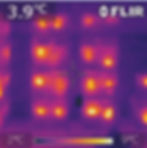What do bees do in winter?
- Lorraine
- Jan 10, 2020
- 2 min read
Updated: Jan 9, 2024
In this blog we explore the surprisingly warm world of the honeybee in winter.

Unlike most other insects in our UK climate, honeybees don't overwinter in some kind of inactive state - such as torpor or hibernation. Inside their nest, they are active all year round but cold weather is still their enemy.
Individual bees contract their flight muscles to generate heat - a bit like we jog on the spot to warm up!
The honeybee hive is a carefully balanced world where the bees live, store food and raise their young. During the spring and summer when they have brood (the name beekeepers give to honeybee young - eggs and larvae) they keep the nest at a constant 33-36C. Their eggs and larvae need this temperature to develop properly. If the nest temperature falls below 33C, the bees generate heat from their flight muscles. If it gets too warm, they fan inside the hive to cool it.
In the winter, it's usually too cold to raise young but the adult bees (a skeleton crew of about 10,000 of them) still need to keep themselves warm. Below 18C they can't generate heat from their muscles. Below 8C they go into a coma and eventually die.
To stop this happening the bees start to huddle together. When the outside temperature reaches about 14C, the thousands of bees start to form a cluster. The bees on the outside of the cluster act as insulation for the bees in the middle who contract their flight muscles - so generating the heat needed to keep the cluster warm. In the centre will be their precious queen and perhaps a tiny amount of brood. Amazingly, when the outside temperature is many degrees below freezing, inside the cluster it can still be 33C.
A honeybee cluster behaves like a warm blooded animal to keep its winter temperature up.
But there are no flowers - what do bees eat in winter?
Just like lots of other insects, honeybees rely on summer flowers to provide them with nectar. Nectar is full of sugar and this is the bee's energy source. Over the long months of summer the bees work hard to gather as much nectar as possible. They process it into honey - which they store in their hive. In the winter, the bees eat their stores of honey. Their own needs are tiny in comparison to the quantity - about 20kg - they need for their flight muscles to warm their cluster.
So, all the bee's hard work in the summer is really to prepare the colony to get through winter. It means they have a head start over other insects because a force of 10,000 bees is all ready to get going when new flowers appear next spring. It's an incredible piece of evolution.
